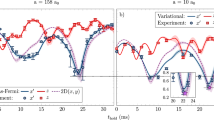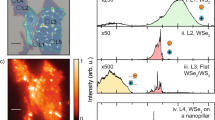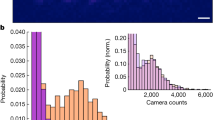Abstract
Research on matter waves is a thriving field of quantum physics and has recently stimulated many investigations with electrons1, neutrons2, atoms3, Bose-condensed ensembles4, cold clusters5 and hot molecules6. Coherence experiments with complex objects are of interest for exploring the transition to classical physics7,8,9, for measuring molecular properties10, and they have even been proposed for testing new models of space-time11. For matter-wave experiments with complex molecules, the strongly dispersive effect of the interaction between the diffracted molecule and the grating wall is a major challenge because it imposes enormous constraints on the velocity selection of the molecular beam12. Here, we describe the first experimental realization of a new set-up that solves this problem by combining the advantages of a so-called Talbot–Lau interferometer13 with the benefits of an optical phase grating.
This is a preview of subscription content, access via your institution
Access options
Subscribe to this journal
Receive 12 print issues and online access
$259.00 per year
only $21.58 per issue
Buy this article
- Purchase on SpringerLink
- Instant access to full article PDF
Prices may be subject to local taxes which are calculated during checkout




Similar content being viewed by others
References
Ji, Y. et al. An electronic Mach–Zehnder interferometer. Nature 422, 415–418 (2003).
Hasegawa, Y., Loidl, R., Badurek, G., Baron, M. & Rauch, H. Violation of a Bell-like inequality in single neutron interferometry. Nature 425, 45–48 (2003).
Schumm, T. et al. Matter-wave interferometry in a double well on an atom chip. Nature Phys. 1, 57–62 (2005).
Pethick, C. J. & Smith, H. Bose–Einstein Condensation in Dilute Gases (Cambridge Univ. Press, Cambridge, 2002).
Schöllkopf, W. & Toennies, J. P. Nondestructive mass selection of small van der Waals clusters. Science 266, 1345–1348 (1994).
Arndt, M. et al. Wave-particle duality of C60 molecules. Nature 401, 680–682 (1999).
Giulini, D. et al. Decoherence and the Appearance of a Classical World in Quantum Theory (Springer, Berlin, 1996).
Zurek, W. H. Decoherence, einselection, and the quantum origins of the classical. Rev. Mod. Phys. 75, 715–775 (2003).
Hackermüller, L., Hornberger, K., Brezger, B., Zeilinger, A. & Arndt, M. Decoherence of matter waves by thermal emission of radiation. Nature 427, 711–714 (2004).
Deachapunya, S. et al. Thermal and electrical properties of porphyrin derivatives and their relevance for molecule interferometry. J. Chem. Phys. 126, 164304 (2007).
Wang, C.H.-T., Bingham, R. & Mendonca, J. T. Quantum gravitational decoherence of matter waves. Class. Quant. Grav. 23, L59–L65 (2006).
Brezger, B., Arndt, M. & Zeilinger, A. Concepts for near-field interferometers with large molecules. J. Opt. B 5, S82–S89 (2003).
Clauser, J. F. in Experimental Metaphysics (eds Cohen, R. S., Horne, M. & Stachel, J.) 1–11 (Kluwer Academic, New York, 1997).
Gronniger, G. et al. Electron diffraction from free-standing, metal-coated transmission gratings. Appl. Phys. Lett. 87, 124104 (2005).
Keith, D. W., Ekstrom, C. R., Turchette, Q. A. & Pritchard, D. E. An interferometer for atoms. Phys. Rev. Lett. 66, 2693–2696 (1991).
Carnal, O. & Mlynek, J. Young’s double-slit experiment with atoms: A simple atom interferometer. Phys. Rev. Lett. 66, 2689–2692 (1991).
Chapman, M. S. et al. Optics and interferometry with Na2 molecules. Phys. Rev. Lett. 74, 4783–4786 (1995).
Freimund, D. L., Aflatooni, K. & Batelaan, H. Observation of the Kapitza–Dirac effect. Nature 413, 142–143 (2001).
Gould, P. L., Ruff, G. A. & Pritchard, D. E. Diffraction of atoms by light: The near-resonant Kapitza–Dirac effect. Phys. Rev. Lett. 56, 827–830 (1986).
Nairz, O., Brezger, B., Arndt, M. & Zeilinger, A. Diffraction of complex molecules by structures made of light. Phys. Rev. Lett. 87, 160401 (2001).
Cronin, A. D. & McMorran, B. Electron interferometry with nanogratings. Phys. Rev. A 74, 061602(R) (2006).
Cahn, S. B. et al. Time-domain de Broglie wave interferometry. Phys. Rev. Lett. 79, 784–787 (1997).
Brezger, B. et al. A matter-wave interferometer for large molecules. Phys. Rev. Lett. 88, 100404 (2002).
Casimir, H. B. G. & Polder, D. The influence of retardation on the London–van der Waals forces. Phys. Rev. 73, 360–372 (1948).
Brühl, R. et al. The van der Waals potential between metastable atoms and solid surfaces: Novel diffraction experiments vs. theory. Europhys. Lett. 59, 357–363 (2002).
Fagan, P. J. et al. Production of perfluoroalkylated nanospheres from buckminsterfullerene. Science 262, 404–407 (1993).
Gotsche, N., Ulbricht, H. & Arndt, M. UV–VIS absorption spectroscopy of large molecules for applications in matter wave interferometry. Laser Phys. 17, 583–589 (2007).
Hornberger, K., Sipe, J. E. & Arndt, M. Theory of decoherence in a matter wave Talbot–Lau interferometer. Phys. Rev. A 70, 053608 (2004).
Savas, T. A., Schattenburg, M. L., Carter, J. M. & Smith, H. I. Large-area achromatic interferometric lithography for 100 nm period gratings and grids. J. Vac. Sci. Technol. B 14, 4167–4170 (1996).
Tamai, N. & Miyasaka, H. Ultrafast dynamics of photochromic systems. Chem. Rev. 100, 1875–1890 (2000).
Acknowledgements
The project is supported by the Austrian FWF within the projects START Y177-2 and SFB F1505 and by the European Commission within the RTN network HPRN-CT-2002-00309. K.H. acknowledges support by the DFG Emmy-Noether program. M.M. and M.M. acknowledge support from the Swiss National Science Foundation (SNSF) and the Innovation Promotion Agency (CTI). We thank A. Zeilinger for lending us a continuous-wave laser.
Author information
Authors and Affiliations
Contributions
The interferometry work was carried out by S.G., L.H., A.S., H.U., M.G., F.G. and M.A. Analysis was carried out by K.H. and S.G. The nanogratings were prepared by T.S. in collaboration with L.H. S.G. and L.H. contributed equally to the experiment. M.M. and M.M. designed, synthesized and characterized the fluorinated azobenzene derivative with high vapour pressure.
Corresponding authors
Ethics declarations
Competing interests
The authors declare no competing financial interests.
Supplementary information
Rights and permissions
About this article
Cite this article
Gerlich, S., Hackermüller, L., Hornberger, K. et al. A Kapitza–Dirac–Talbot–Lau interferometer for highly polarizable molecules. Nature Phys 3, 711–715 (2007). https://doi.org/10.1038/nphys701
Received:
Accepted:
Published:
Issue date:
DOI: https://doi.org/10.1038/nphys701
This article is cited by
-
The Physical Foundation of Quantum Theory
Foundations of Physics (2023)
-
Testing the foundation of quantum physics in space via Interferometric and non-interferometric experiments with mesoscopic nanoparticles
Communications Physics (2021)
-
Test quantum mechanics in space — invest US$1 billion
Nature (2021)
-
Quantum superposition of molecules beyond 25 kDa
Nature Physics (2019)
-
Measuring finite-range phase coherence in an optical lattice using Talbot interferometry
Nature Communications (2017)



